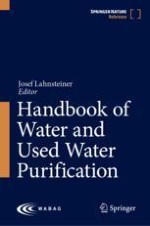Abstract
This chapter describes the reclamation of water from drought-proof, municipal effluent sources, and the reuse of the reclaimed water in the Beijing Olympic Park. The main drivers for water reuse have been water stress, water eco-system destruction, loss of surface water bodies, and the intention to improve the urban landscape for the 2008 Summer Olympic Games and beyond.
In order to alleviate its water crisis, during recent years the city of Beijing has supported the development of water reclamation and reuse. The “dragon-shaped” water system in the Beijing Olympic Park is a successful example of recreational water landscapes using reclaimed water over a period of more than ten years. Artificial water landscapes usually face the risks of quality deterioration and water algal blooms, and therefore, maintaining proper water quality is extremely important.
Since 2008, five reclamation plants at QingHe and BeiXiaoHe with a total capacity of 650,000 m3/d have supplied water to the Olympic Park for irrigation, toilet flushing, recreational reuse (such as make-up water for fountains), and the replenishment of the “dragon-shaped” water system. All five of these facilities employ membrane filtration (membrane bioreactors and tertiary ultrafiltration) as a core technology, but differing post-treatment systems (such as reverse osmosis, ozonation, and disinfection). The details of the reclamation plants and the membrane units are described.
A constructed wetland and a series of ponds further polish the reclaimed water, which is blended into the landscaped water system in order to control the risk of algal blooms and maintain the good quality of the landscaped lake waters. Algal blooms may occur in scenic water created by reclaimed water in summer, even if nitrogen and phosphorus concentrations are very low. Consequently, it is necessary to setup the ecological purification processes and maintain the scenic water quality. Over 90% of the Beijing population accept water reclamation and reuse for noncontact recreational landscaping purposes, but demonstrated low levels of acceptance with regard to other reuse fields, for example, car washes, agricultural irrigation, and residential toilet flushing based on questionnaires (Chen and Jiao, Environ Sci (in Chinese) 33(12):4133–4140, 2012).
The employment of reclaimed water can provide both notable economic and environmental benefits. In the case of water landscape system in the Beijing Olympic Park, as compared to the use of tap water, some CNY 9.38 million p.a. (EUR 113,800 p.a.) (i.e., saved costs of buying tapwater instead of using reclaimed water) were saved in the years between 2008 and 2014. It can therefore be stated that this successful project has contributed significantly to an improvement in the economic, environmental, and social sustainability of the capital city of Beijing.
